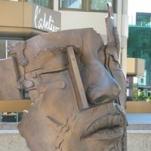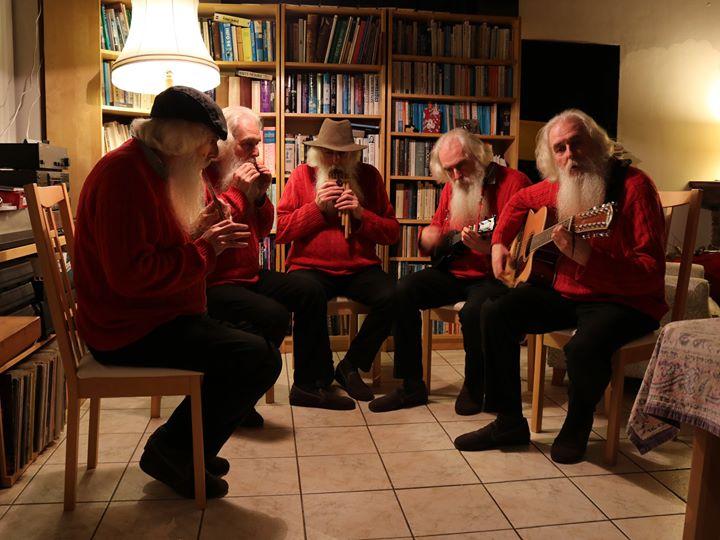-
Posts
28 -
Joined
-
Last visited
About Hughes

Profile Information
-
Gender
Male
-
Location
Elham, Kent, UK
-
Occupation
I have a small-holding
-
Favorite Composers
Vivaldi, Beethoven, Sibelius, Mahler, Rachmaninoff, Ralph Vaughan-Williams, Olivier Messiaen, Aaron Copland, George Gershwin, Peter Maxwell-Davis, Arvo Part, John Adams, Philip Glass
-
My Compositional Styles
Too new to composition to know: I am trying out everything. especially Interested in jazz, folk-song, minimalist music, and electronic music.
-
Notation Software/Sequencers
Musescore
-
Instruments Played
Ukulele, guitar.
Recent Profile Visitors
The recent visitors block is disabled and is not being shown to other users.
Hughes's Achievements
-
Hughes changed their profile photo
-
I am embarrassed that it took me a year to 'complete' two compositions (Obsidian and Voile d'automne). People in this forum wisely advised that I should 'lose my first hundred compositions quickly', so as to learn from my errors and move on. So this morning (Christmas eve) I determined to complete an albeit short composition in a day. Here it is, a simple fugue. I sketched the basic idea while out walking in a local wood, transcribed it when I arrived home, and developed it through the day. I hope that I have avoided orthographic issues, which have dogged much of my work to date. As the complexity of the piece increased, I realised that dynamics play an important role. I use MuseScore both for transcription and for playback. With MuseScore playback the scored dynamics work (reasonably) well, and I hope that this remains the case with the MP3 file. One of the issues I soon discovered is that I had to cheat by altering some notes to avoid unwanted dissonances. I should appreciate guidance on how I ought to be handling the issue. I participate in this forum because I am eager to learn. Feedback will be gratefully received. In an early scene in Roman Polanski's movie of Thomas Hardy's novel Tess of the d'Urbervilles, a bevy of young woman dressed in white dance round a maypole. The simple country music swells as the observer approaches the maypole, and falls again as the viewer departs. Happy Christmas.
-
KJthesleepdeprived, many thanks for your feedback in response to listening to Voile d'automne. When I first started working on the composition, it was very simple, and I called the piece Ilsa's Theme, with the idea of Lara's Theme (from the movie of Dr Zhivago) in mind. Ilsa's Theme runs through Voile d'automne until the final section when it is only a memory and not actually present. (When Lara (Julie Christie) is driven away in a sleigh from Varykino, that is the last time Zhivago (Omar Sharif) ever sees her, even though she lives on in his poems.) I am grateful that you should have spent time listening to Voile d'automne, and going to the trouble of giving me feedback. Thank you.
-
jawoodruff, many thanks for your valuable feedback. 1. The rationale for the order in which the instruments were presented on the score was simply pitch. Thank you for your guidance on this point. I am ignorant, but trying to learn. 2. Legato: probably. Slurs: actually definitely in places. Staccato: no, not in this piece (but I did use staccato judiciously in Obsidian). I write using MuseScore, and have been unable to hear any distinction in the playback facility between slurred and unslurred notes. However, the point you make is about variation and distinction of musical textures. Undoubtedly a learning point. 3. In my naive ignorance, I knew nothing about voice leading until you mentioned it. I tried to write what I thought sounded good or fitting. However, now you have introduced me to the term, I shall study its rules further and in depth. 4. Thank you for your guidance on avoiding over-complicating the score with repeated changes in key signature. I am grateful that you should have spent time listening to Voile d'automne, and going to the trouble of giving me feedback. Thank you.
-
Quinn, thank you for your valuable response to Obsidian. I have been thinking a lot about each of the points you have made, and I intend to respond - not defensively, I hasten to add. 1. Whilst the work is indeed mine, I am far from confident about most aspects of musical composition. Just as people sometimes comment, on seeing a person walking a large dog: "Are you taking the dog for a walk, or is the dog taking you?" 2. Nowhere is the first point more evident than in terms of key signatures. In Obsidian I tried, wherever possible, to make the notes on the line as uncluttered as possible, changing the key signature accordingly. (However, I was not even fully consistent with this principle.) As ever, I was composing 'by ear'. For me, therefore, the piece is not in any specific key or keys - probably a nightmare for the oboe and bassoon. On what principles do other people address this issue? 3. I use MuseScore both for writing and for playback. The dynamics throughout the piece are what works for MuseScore playback. I am aware, however, that this could vary were an ensemble to play the piece live. From what you have written, it sounds like that variation could be quite substantial. Unless you are able to suggest otherwise, I guess that I am only really likely to get written dynamics right if the piece were to be played. 4. I was interested that you should pick out the section from bar 35, where you consider that the texture is muddy. I had played this section in an earlier incarnation countless times over many months, knowing that it lacked something. Only very recently I wrote the 'cello line, which improved things. However, accepting your feedback, I think I need to take out one of the other lines so as to 'unmuddy' the section. 5. The Lisztian hand-stretches (aptly-termed) expose the fact that I wanted to make use of some very bleak-sounding chords - to date, all of my compositions had been bright and fairly upbeat. I am more interested in darker music (Mahler, Rachmaninoff, Shostakovitch and Sibelius, among others) as well as less rigid music (such as Vaughan Williams), and naturally would like to explore those ideas. By way of beginning, I composed Obsidian for piano, and one of the reasons for orchestrating it for a small chamber orchestra was to make those many-fingered 11th chords feasible. However, there were a few places where I failed, and left the pianist requiring too many fingers. My bad. 6. Although there are key changes, the piece is written in Mixolydian from bar 8 to bar 88; in Locrian from bar 89 to bar 134 (with bars 126 - 129 failing to cadence on A flat minor to E flat diminshed; followed by bars 130 - 133 searching in vain for an alternative cadence); alternating between Dorian and Locrian (Dorian 135 - 138; Locrian 139 - 142; Dorian 143 - 146; Locrian 147 - 175, the last section of which arrives once again at the failure to cadence), which is resolved by moving into Mixolydian (although my memory might be a little dodgy about this); the final two sections before the cadencing coda are both in Mixolydian. 7. Philip Glass (e.g. Koyaanisqatsi), John Adams and Michael Nyman (introduced through the soundtracks of several Peter Greenaway movies) are vital to my musical ear. 8. I should be most interested to hear your symphonic piece for strings in Locrian mode. Where might I find it. Thank you again for taking the trouble to listen to Obsidian and offering critique. I am sincerely grateful.
- 5 replies
-
- mixolydian
- dorian
-
(and 1 more)
Tagged with:
-
I started writing this piece a year ago, and worked on it for about four months. Then I put it to one side and started on a more melodic piece (Voile d'automne). Having completed the latter I was able to return to the former piece and complete it (as far as any piece is completed). So, here it is. I based it on a lengthy chord progression. I wanted to explore a darker soundscape than in previous compositions, use many more exotic chords (the sound of which I really appreciate), and employ several different modes. I was mildly intrigued that the locrian mode doesn't cadence, and so confronted this issue directly. One of the (no doubt many) weaknesses of the piece is that I have not found an adequate way to make greater use of a) the marimba; b) the voices. I did not want simply to include them when they were not needed just because they were there, yet I feel uncomfortable about how little contribution they make to the piece. As always, all feedback will be gratefully received.
- 5 replies
-
- 1
-

-
- mixolydian
- dorian
-
(and 1 more)
Tagged with:
-

My First Work for a Full Orchestra!
Hughes replied to Rabbival507's topic in Orchestral and Large Ensemble
It is a long time since I was last on this site, and I have missed hearing your compositions. It was a delight, therefore to find this fragment. I have listened to it half a dozen times, each time hearing it more clearly. I have also looked over the score, although I do not have perfect pitch so I am unable to 'hear' music this way. First, the piece is exactly as you entitle it: a call to adventure. Having watched a great many action and adventure movies, your piece fits the genre perfectly. Well done. I was not reminded of The Shire, despite having watched The Hobbit and The Lord of the Rings trilogies many times. If pushed I would say that there was the very mildest of resemblances to the Pirates of the Caribbean theme, but less Irish and more English, somehow. I am more reminded of the Westerns I used to watch many years ago as a child. So, I do not believe you have any reason to be anxious that your composition is specifically derivative. Second, on first listen, there were several places where the simple rhythm got a bit lost. On listening more I could hear that, in fact, something more complex was going on, as I would expect of serious music. However, in my stereotyping of the genre, I would say that the simple rhythm needs to be obvious, although not necessarily forefronted, throughout any 'A' sections. In contrast to what I have just written, were I listening to Sibelius, I would expect to hear simple rhythms become increasingly complex, which is ultimately more interesting. Third, on listens after my first, I was very keen for the piece to continue. Specifically, I was looking towards a somewhat darker 'B' section (perhaps then followed by a return to the 'A' theme). Fourth, try as could, I was unable to hear the harp. From the score I knew the harp was playing, and I was looking forward to the glissandi, but I just could not hear them. Fifth, and following on from four, I am going to be very bold, inasmuch I am sure that many others on this site are able to advise you better that I ever could. I think that if you want phrases on specific instruments to be heard, then you need to make holes in which that can happen. In my limited experience, this seems to apply especially to the quieter instruments. I did hear the xylophone, albeit only once, towards the end of the piece. Of course, the other obvious way to handle this would be to include several harps, etc., so as to increase their sound volume in relation to the other, louder instruments. Sixth, I liked the balance you brought between passages in which multiple threads were being pursued, passages that were harmonious with the theme/melody, and passages that were unison, emphasising the theme/melody. That balance, it seems to me, fits well with the genre. Orchestral music is usually my preferred musical environment. I am, therefore, excited that you are interested in adapting your talents to include orchestral music. I look forward to hearing where you might take this piece, should you develop it further, and to future orchestral pieces you might compose. -
I have been working on this composition for about eight months, I think. I have attempted to take note of all the feedback I have received to date in this forum, with the exception of 'try to work fast at producing more compositions instead of tinkering endlessly with one piece.' If you don't warm to different things going on at the same time, you will not warm to Voile d'automne: probably you will consider it a dog's breakfast. I have been concerned to keep the music melodically interesting. Do I succeed? Or have I overdone it? I have been concerned to produce different soundscapes (including the employment of different modalities) yet maintain an overall sense of unity. I believe I have been successful at this, but do you agree? Compared with previous compositions, I have tried to make use of different rhythms. Does this work? Some parts of the work are melody-led, and other parts are chord led. Do you think I have the balance anywhere near right? I should like to have been much more adventurous in the chords I was using (other than the chords made with passing notes), but I do not know how to achieve that without starting with a chord progression. Advice would be welcome. I am not at all competent at building to a final a cadence. Where can I turn for some guidance on this? Any feedback you are able to give me will be gratefully received.
-
jumbalo I have now listened to your piece more than half a dozen times. Broadly, I find it enjoyable, emotionally upbeat, and if the title of the piece is anything to go by, fits well the category of 'corporate' music. I don't experience it as silly at all, and I am wondering what makes you think that it is. I am not sure what you mean by "indirect". I like the range of instruments you have used, and they sound as though they fit the category. I like the use short notes (pointillism), which also fits the category. I like the fact that you bring in longer notes towards the end of the piece, giving some sense of progression. I like the quieter way you start the piece, and build up its richness. I like the fact that you have subtle variations constantly being introduced throughout. I am fairly sure that I understand what you were attempting with the 'middle section', and I like it a lot. It introduces interest without departing completely from the 'loop'. Personally, I think you rush through the middle section. I would want to expand it, and introduce the ideas in the counter-rhythms a little more gradually so you take the listener with you. The only thing that started to irritate me was the heaviness of the two drumbeats. (The more gentle, single drumbeat during the introduction was absolutely fine.) The image I have is of being presented with a nicely cooked meal, and then someone smothering it in tomato ketchup. I found that I was having to mentally block out the heavy drumbeats in order to listen to what else was going on. Looping as a technique is something that interests me, not least because I very much enjoy the music of Philip Glass and John Adams. My sense is that, if you can work out how to move forward your ideas using looping techniques, your piece, and others like it that you may yet write, have a lot of potential. Good luck.
-
Rabbival507 Sorry that I am coming to this posting late. (I had not previously looked in this forum.) The fragment is delightful, and there are many aspects of it that I like very much. In particular, I like the path taken by successive notes: it is not a well-worn path, and sounds wonderful. I guess that this is due to the Miyako-Bushi scale (of which I had not previously heard, but have since read about online). However, in my almost completely untutored opinion, I associate the piece more with 1960s jazzy flute music (which I like) than with traditional Chinese or Japanese music that I have listened to (and which, if I am honest, I have found rather demanding). I think that my opinion is coloured both by your use of a piano, which gives the piece a richness (that I like), and by the rhythms of the piece, which are attractive. The 'ending' resolution sounds very western to my ear. A Japanese aesthetic would have it as feeling more melancholy and less resolved. Here are two YouTube uploads that are unalloyed Japanese music: Whilst the lyrical flute does evoke the wind, the trilled flute sounds like birdsong. (I might use that idea myself, as I have a longstanding interest in birdsong.) At least on the equipment I am using, the sound of the cello is not clearly distinguished from that of the piano. My humble opinion would be that if you want some of your music to sound more Far Eastern, then you may need to write for appropriate instruments, such as the shakuhachi and koto. On the other hand, I like what you are doing with this fragment, and I should very happy to listen to more.
-
Unusual, to my ear. Interesting. There is much that I do not understand. For example, what is the purpose / meaning of the spoken words? Why are the spoken words first in English, and then at the end in German? Maybe the questions are the point. I did have a sense that the spoken German brought the piece (even if actually only a fragment) to a close.
- 3 replies
-
- synthesizer
- eftos
-
(and 1 more)
Tagged with:
-
Gregory Carnage, thank you for uploading this composition. I enjoyed listening to it. It is lively and fun, and I suspect that a badly-behaved Mozart would have approved.
-
epii, as a ukulele player myself, I was, at least in spirit, playing along with you while listening to the piece. I loved the run-downs, and wondered what they (the chords) were. I am envious of you getting to play your ukulele with musicians using other instruments: I am limited either to massed ukuleles (who refuse to consider the inclusion of other instruments), or playing at home accompanied by my wife on her flute. The arrangement on here of your piece is post-rebalancing and so sounds perfect. One question: why did you choose an even strum pattern, rather than choose a strum pattern (or patterns) to bring out some of the off-beats?
-
Bryla, this piece sounds so totally authentic that I wanted it to be from a movie of which I could buy the DVD. Nothing sounds out of place or superfluous. It is as though you know this kind of music inside out - and from the fact that you say that you wrote it in a couple of hours, I guess that you really do know the genre very well indeed. I enjoyed it a lot. Well done.
-
epii, I enjoyed listening to this instrumental song. It does have something of a Beatles ambience, and I was actually reminded of one or two tracks on Revolver (if you know it). Like some of the other comments above, I thought that the bass side was a little heavy. I should also have preferred the flute to have felt a little more nimble. I particularly enjoyed some of the lovely chord sequences and transitions (which is something at which the Beatles excelled). More, please. By the way, I had no problem with Box.com: an online client loaded and I was able to play the piece without further ado.
-
JBegly, what a fantastic song! In my view it is an obvious candidate for the opening credits music for the next Bond movie. If I had not encountered your song on this website, I should have been trying to work out which Bond movie I haven't yet watched. Well done.




